Gardens by the Bay’s Flower Dome scales new heights with alpine floral display from Switzerland
Sign up now: Get ST's newsletters delivered to your inbox
Follow topic:
- Gardens by the Bay presents Alpine Adventure, a floral display with architecture and folk art, premiering Sept 8.
- Designers studied Alpine flora, selecting similar climate-appropriate plants such as large begonias, asters and salvias.
- The show aims to capture Alpine landscapes' layered textures, diverse forms and splashes of colour.
AI generated
SINGAPORE – What would Switzerland’s alpine plants and quaint mountain towns look like when recreated in the tropics? In a word: spectacular.
Gardens by the Bay’s new month-long showcase, Alpine Adventure, which opens at the Flower Dome on Sept 8, is billed as the first of its kind.
It reimagines the land-locked European country’s mountainous landscape in Singapore, complete with iconic architecture, breathtaking blooms and intricate folk paper art.
To simulate the look and feel of an authentic Swiss alpine landscape, the floral display designers studied alpine flora and selected close to 60 per cent of the plants for research horticulturists to grow in-house.
These were chosen for qualities such as being climate-appropriate with similar textures, heights and colours.
The showcase – which was conceived more than a year ago – features a plant palette comprising about 6,000 plants across 50 varieties of alpine and seasonal blooms. On display at the show are larger-than-usual begonias in red, pink and white; as well as asters, salvias and geraniums.
While the plants are cultivated varieties that are larger and showier, the display’s design and layout still follow the layering and rhythm of a natural meadow.
This balances authenticity with the visual impact expected of a show garden, honouring the alpine spirit while immersing visitors in a memorable experience.
True alpine plants are small, compact and adapted to survive sub-zero temperatures. They cannot thrive in the tropics, even in the Flower Dome’s controlled conditions.
So, the designers selected relatives and cultivated varieties that echoed the alpine plants’ colours, textures and layered look. Research horticulturists then carefully curated these in-house at Gardens by the Bay’s back-of-house cooled nursery.
One of the top draws is the collection of begonias, nurtured to produce blooms of up to 10cm in diameter – almost twice the size of common varieties.
To set the stage, the local teams worked closely with overseas experts to recreate other Swiss icons, such as a replica of Zurich’s St Peter’s Church, famed for having the largest clock face in Europe.
There is also a homage to the Fraumunster Church, renowned for its haunting stained-glass windows by Russian-French artist Marc Chagall.
A remake of one cabin of The Glacier Express – known as the slowest, yet most beautiful train in the world – is expected to be another crowd favourite.
There will also be displays of Swiss paper-cutting folk art and an alphorn, an extra-long wooden alpine instrument used by farmers to gather livestock and alert one another across hill and dale.
Spread across about 11,300 sq ft, the show is a tie-up between Gardens by the Bay and Switzerland Tourism.
The two organisations recently invited The Straits Times for a week-long trip to key attractions in Switzerland that were integral to the crafting of the immersive Flower Dome experience.
Zurich and Geneva’s standout attractions
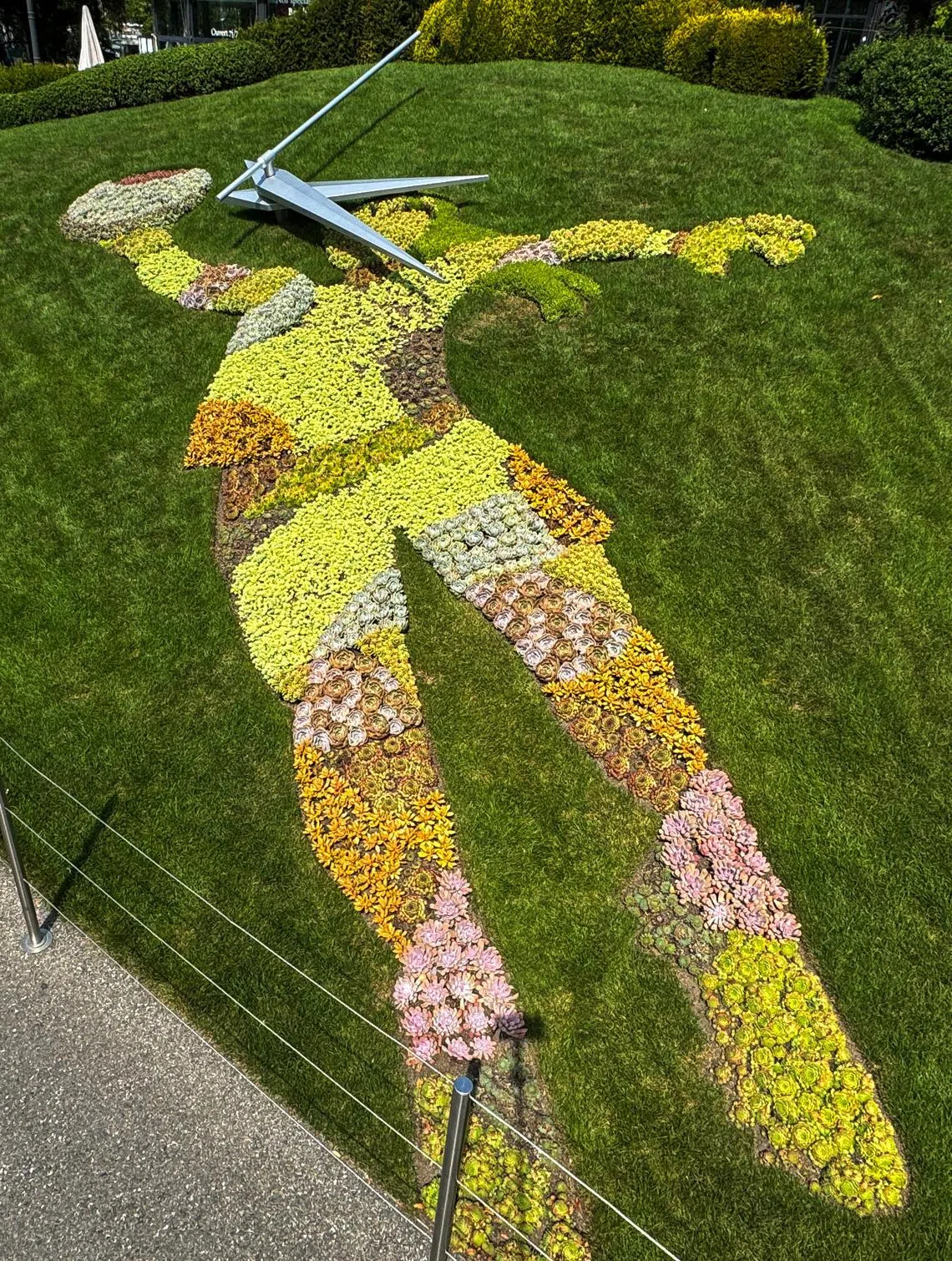
Geneva’s Flower Clock at Jardin Anglais park in Geneva, Switzerland.
ST PHOTO: GIN TAY
Our group of six travellers starts our alpine adventure in Zurich, where the first stop is the Botanischer Garten Zurich (Botanical Gardens of Zurich), one of Switzerland’s best-known urban botanical gardens.
It is recognised for its comprehensive collection of global plant species and educational displays.
A day later, we are in Geneva. The city’s famed Flower Clock or Horloge Fleurie – known as the Botanical Timekeeper and created in 1955 – features more than 12,000 seasonal plants that change throughout the year. It also boasts the world’s longest second hand, measuring 2.5m.
True to Swiss tradition, it keeps perfect time and is being recreated in the Flower Dome.
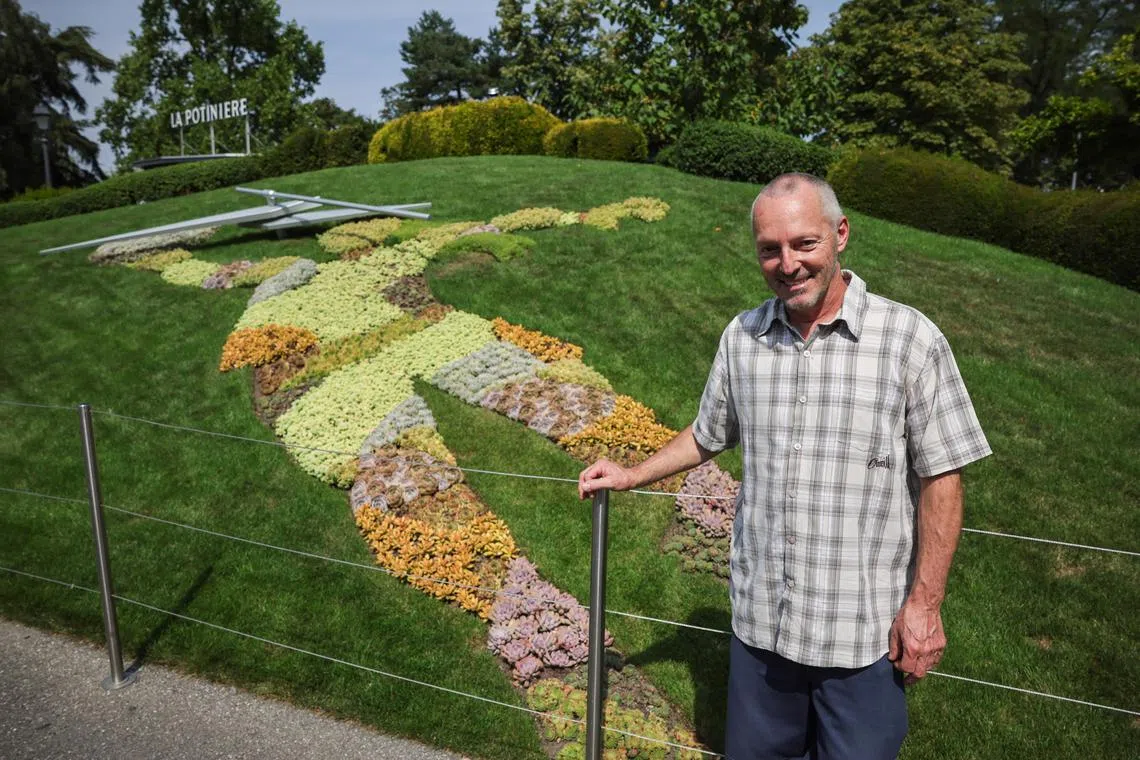
Landscape designer Pascal Bandelier, foreman of the Geneva Green Spaces Department, with Horloge Fleurie (Flower Clock).
ST PHOTO: GIN TAY
At the Jardin Botanique Alpin de Meyrin (Alpine Botanical Garden), the spirit of the Alps thrives in a vibrant oasis just minutes from the city centre.
Founded in the early 1900s, it is home to more than 2,400 temperate-zone plants from around the globe, artfully set among rock gardens, meandering paths, towering cedars and tranquil pods.
The garden is a green lung in the city, inviting visitors to explore an ever-changing patchwork of colours, scents and rare Alpine blooms such as Artemisia borealis, also known as the northern wormwood, and Eryngium alpinum (alpine sea holly).
One of the garden’s botanists, Ms Caroline Jeanneret, says she is concerned about how climate change is adversely affecting alpine flora today.
With rising mountain temperatures, the upper limits of plant distributions are dramatically shifting higher on slopes and peaks, she notes.
“Global warming is causing temperatures in the mountains to rise, which means plants that once could grow only at lower elevations are now able to move higher up the slopes,” she tells The Straits Times.
As a result, many species have “climbed” 20m to 35m in altitude over the last 100 years, taking advantage of warmer weather, more nutrients and longer growing seasons, she says.
This upward shift means new plants are invading territory that once belonged only to true alpine species – those adapted to life above the tree line, where conditions are colder and harsher.
“These newcomers are out-competing classic alpine plants such as gentians and saxifrages, which we’re already seeing less of in favour of fast-spreading grasses,” she adds.
Switzerland’s high-altitude alpine plants are nature’s rugged survivors, sculpted for life where land meets sky.
Above the tree line, the tiny alpine plants huddle close to the earth, braving icy winds, searing sunlight and short summers. Their cushion-like forms can be seen as clumps, wiry mosses and tough grasses which help them adapt to rocky slopes and scanty soils.
To battle extreme winters, alpine plants stockpile energy underground, ready for spring’s short burst of growth.
Unlike their lush relatives in valley meadows, these tiny powerhouses near the mountaintop are expertly engineered for extremes, making gentians, saxifrages and edelweiss Switzerland’s dramatic alpine torch-bearers.
Ms Jeanneret says: “Around 20 per cent of these traditional alpine species are at risk of disappearing entirely. In short, it’s not just the changing climate itself, but also this new competition from plants moving uphill that’s putting alpine wildflowers and mountainous habitats in danger.”
She adds that there is also an urgency to create more awareness about how the loss of snow cover destabilises mountain habitats.
Swiss mountain village charms

Alphorn-maker Johann Schranz with one of the instruments.
ST PHOTO: GIN TAY
Next up is the rustic mountain village of Adelboden, where 78-year-old alphorn-maker Johann Schranz demonstrates how he crafts the instrument at his workshop in his quaint Swiss chalet home.
A few stops away at the Tourist Center in Adelboden, artist Elisabeth Beutler, 63, holds a craft session where she enthrals with her paper prowess, using a tiny pair of scissors to carve out folk art with storytelling motifs.
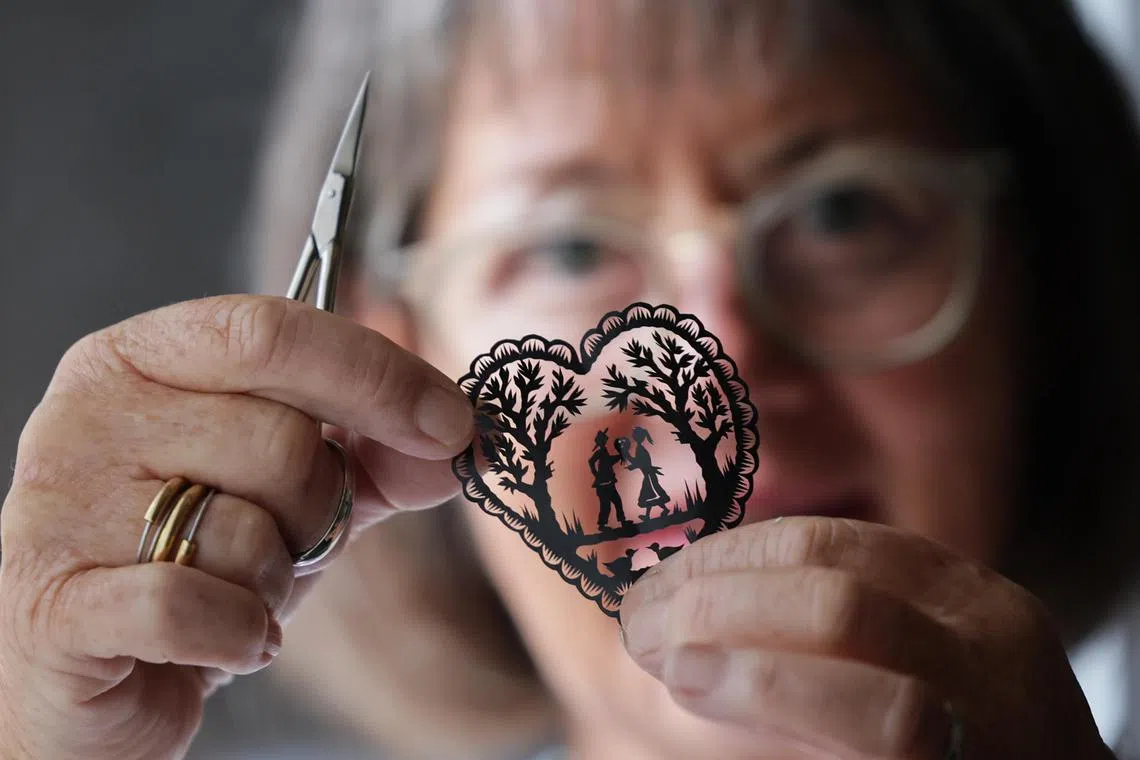
Papercutting artist Elisabeth Beutler with her work at the Tourist Center in Adelboden.
ST PHOTO: GIN TAY
Over the years, Adelboden has attracted younger travellers seeking quieter, nature-rich destinations.
According to the latest Tourism Monitor Switzerland survey, South-east Asian visitors are increasingly drawn to Switzerland’s natural beauty and panoramic landscapes. Social media and influencer partnerships have also been instrumental in reaching independent travellers who prefer flexible itineraries.
This approach also supports Switzerland’s regional diversification goal by spotlighting lesser-known areas, says Mr Batiste Pilet, director for South-east Asia at the Switzerland Tourism office in Singapore.
“By promoting hidden gems like Adelboden and making use of digital platforms, we hope to inspire more individual travellers to explore beyond the usual favourites and discover the many different sides of Switzerland,” says Mr Pilet.
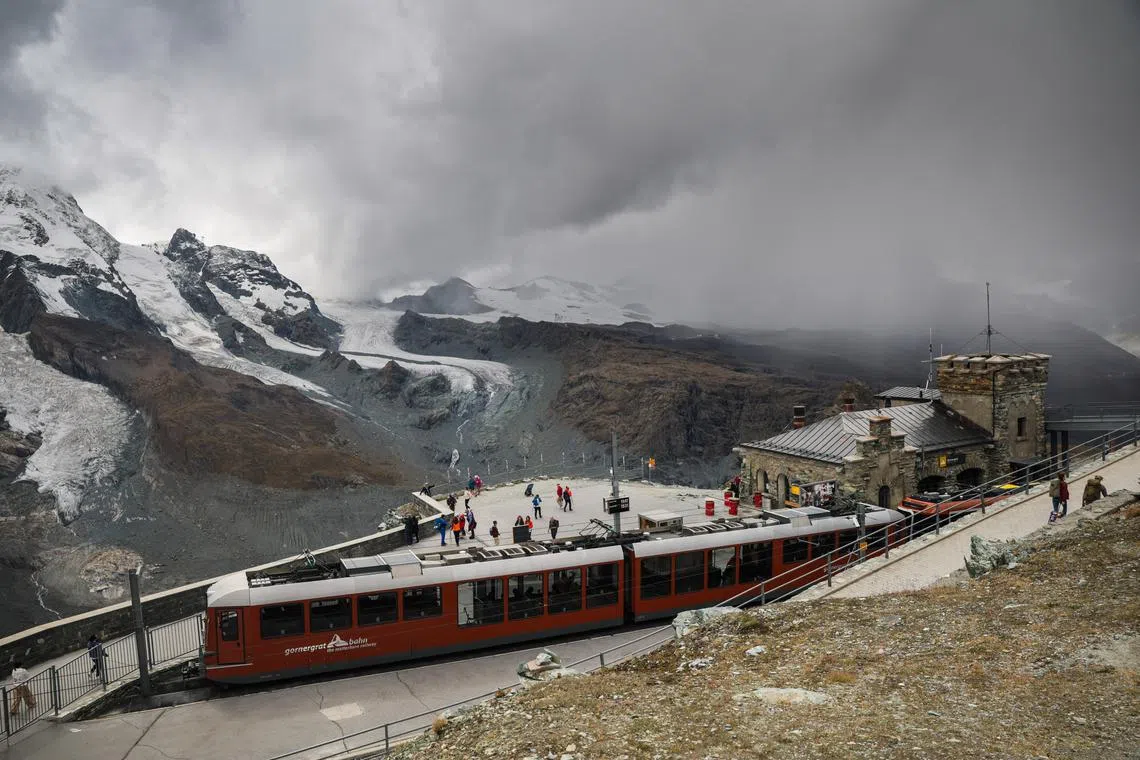
In the backdrop of Station Gornergrat looms the dramatic Matterhorn.
ST PHOTO: GIN TAY
Meanwhile, in the resort town of Zermatt, a rare Alpine Garden in Gornergrat awaits visitors. In the backdrop is the dramatic Matterhorn, which at 4,400m seems perpetually embraced by clouds.
A gardener tends to a dandelion plot in the freezing 5 deg C weather. Gornergrat’s Alpine Garden is the highest in Europe, about 2,800m above sea level.
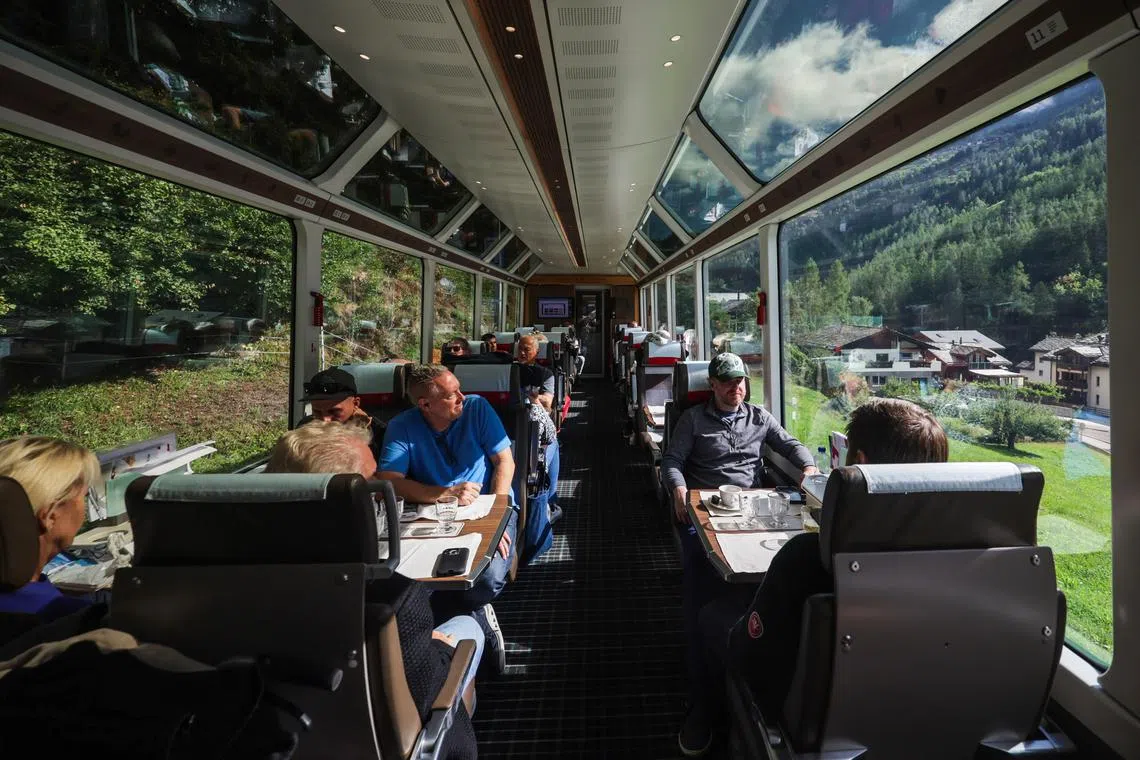
Passengers aboard the Glacier Express.
ST PHOTO: GIN TAY
Before catching the return flight to Singapore, we board the Glacier Express from Zermatt.
On the fabled train – which still chugs along at the same glacial pace it has since the 1930s – we spot black-nosed sheep and alpine cows in the distance, grazing indifferently on the hill slopes.

Black-nosed sheep on the hills.
ST PHOTO: GIN TAY
Alpine essence through colours and textures
Back in Singapore, Ms Sharifah Yasmeen Osman, Gardens by the Bay’s senior manager of research and horticulture, says alpine plants, which grow in mountain environments, are not suited for life in the tropics.
The Gardens’ approach is to reinterpret their essence through plants that mirror colours and textures, and which can thrive in the Flower Dome’s conditions.
To capture the textures and colours of Swiss meadows, designers of the floral display selected plants related to alpine plants – such as hybrids and cultivated varieties that are larger and more colourful, yet able to flourish in the Flower Dome.
Using the in-house cooled nursery facility, research horticulturists were tasked to grow these plants for the Alpine Adventure showcase.
Growing them in-house allowed the research team to regulate conditions precisely and to coordinate the blooming cycles of different plants, so they can all be in peak bloom in time for the opening. It also guaranteed a supply of flowering plants, Ms Sharifah adds.
Another consideration was the palette suggested by the designers.
Alpine meadows are often characterised by softer, muted tones, but as a show garden, Gardens by the Bay had to balance authenticity with visual impact.
“The floral display designers still used a meadow landscape as the inspiration for the planting style. At the same time, they also introduced showier blooms such as cascading begonias to create an installation that is both faithful to the alpine spirit and captivating for our visitors,” she says, pointing out that begonias are a common sight adorning balconies of Swiss chalets in summer.
“These cascading begonias were entirely grown in-house by research horticulturists.”
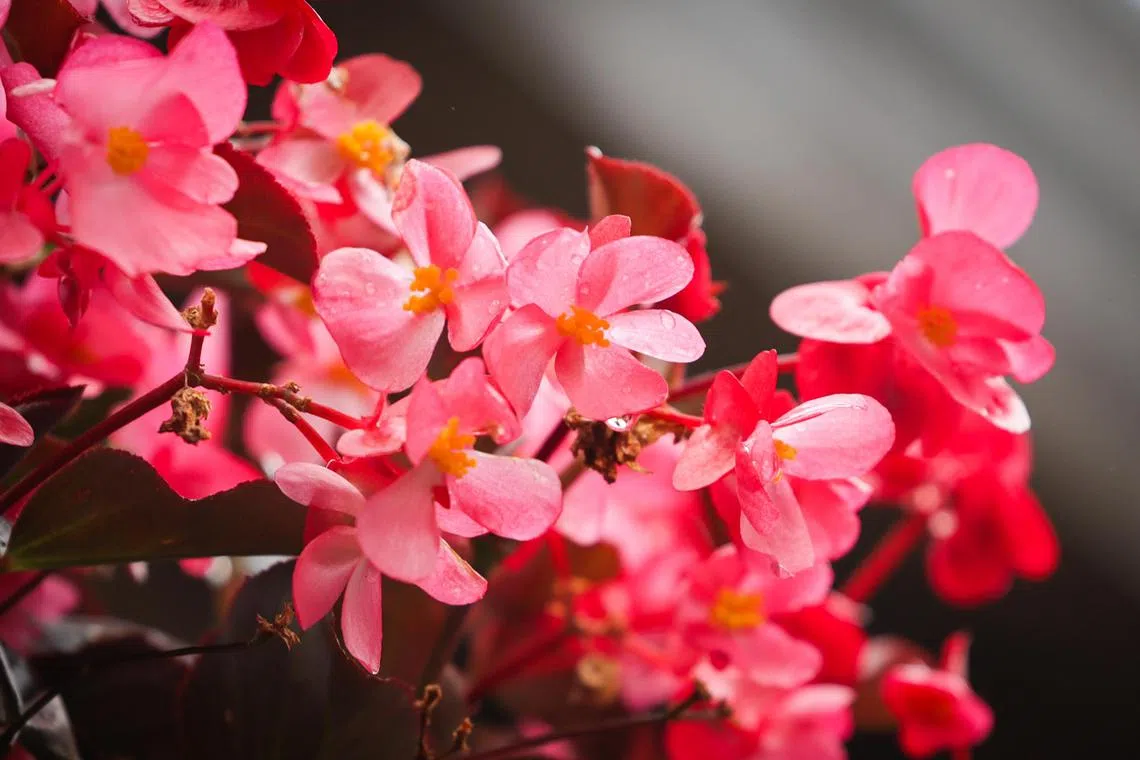
Begonias grown in-house by research horticulturists at Gardens by the Bay.
ST PHOTO: GIN TAY
According to Mr Heng Whoo Kiat, senior director of conservatory operations at Gardens by the Bay, staging an exhibition on alpine flora takes some doing.
“Gardens by the Bay strives to bring the world to Singapore through horticulture. Alpine Adventure is the latest example of how we do this,” says Mr Heng, who joined the group in Zurich.
Floral display designers selected plants that are either relatives of alpine species or bear a strong visual resemblance to them, particularly salvias and asters.
“Various species of salvia occur naturally in alpine regions and are known for their resilience in cooler, rockier conditions,” Mr Heng notes.
“These alpine salvias share botanical traits with cultivated varieties – such as similar flower structures and vibrant colours – and cultivated ones like Salvia Cathedral and Salvia Mirage in the floral display capture the essence of the alpine plant landscape.”
Asters have a strong presence in alpine ecosystems, with species adapted to short growing seasons and cooler temperatures.
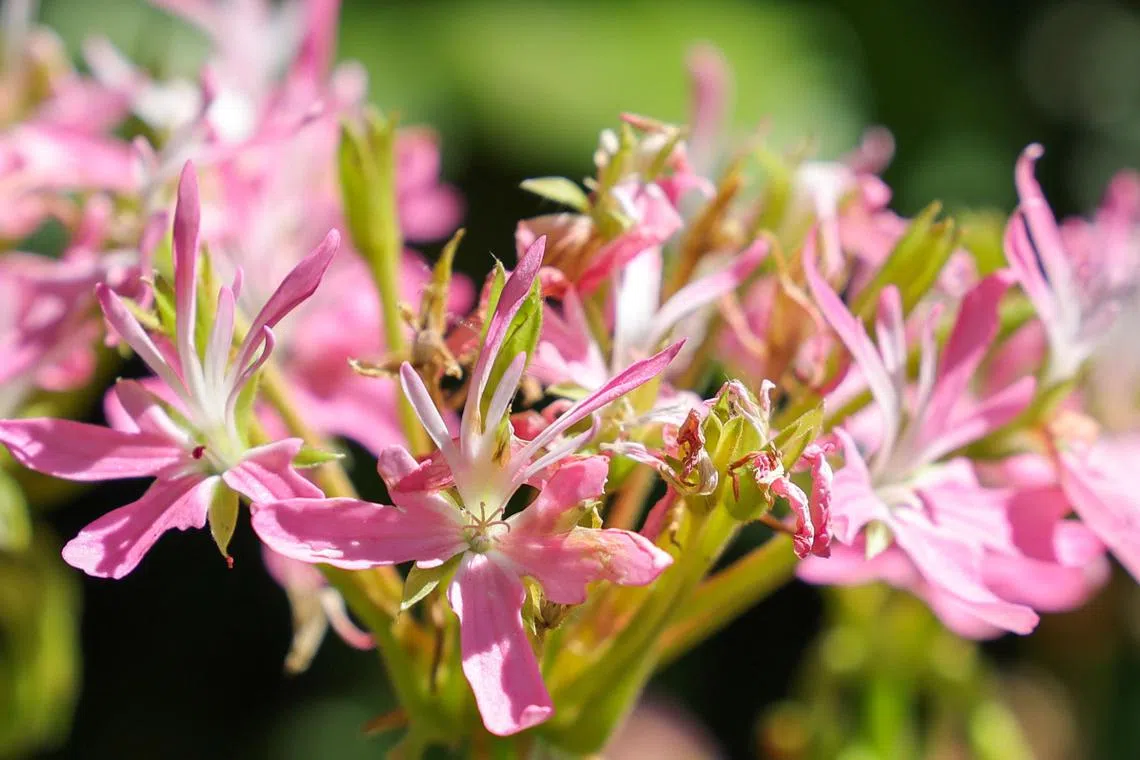
Soft pink cleomes recreate the colour and texture of Swiss alpine meadows.
ST PHOTO: GIN TAY
Mr Heng points out that alpine asters create carpets of daisy-like blooms across mountain meadows, and the cultivated asters featured in the floral display mirror these characteristics with profuse, daisy-shaped blossoms that closely resemble their wild alpine counterparts.
He adds: “By selecting salvias and asters alongside other blooms such as campanulas, cleomes, geraniums, petunias and foxgloves, Alpine Adventure authentically conveys the layered textures, diverse forms and vibrant splashes of colour that define Switzerland’s alpine meadows – reimagined for the tropics.”
5 highlights of Swiss mountain magic
Golden Spot Cabin
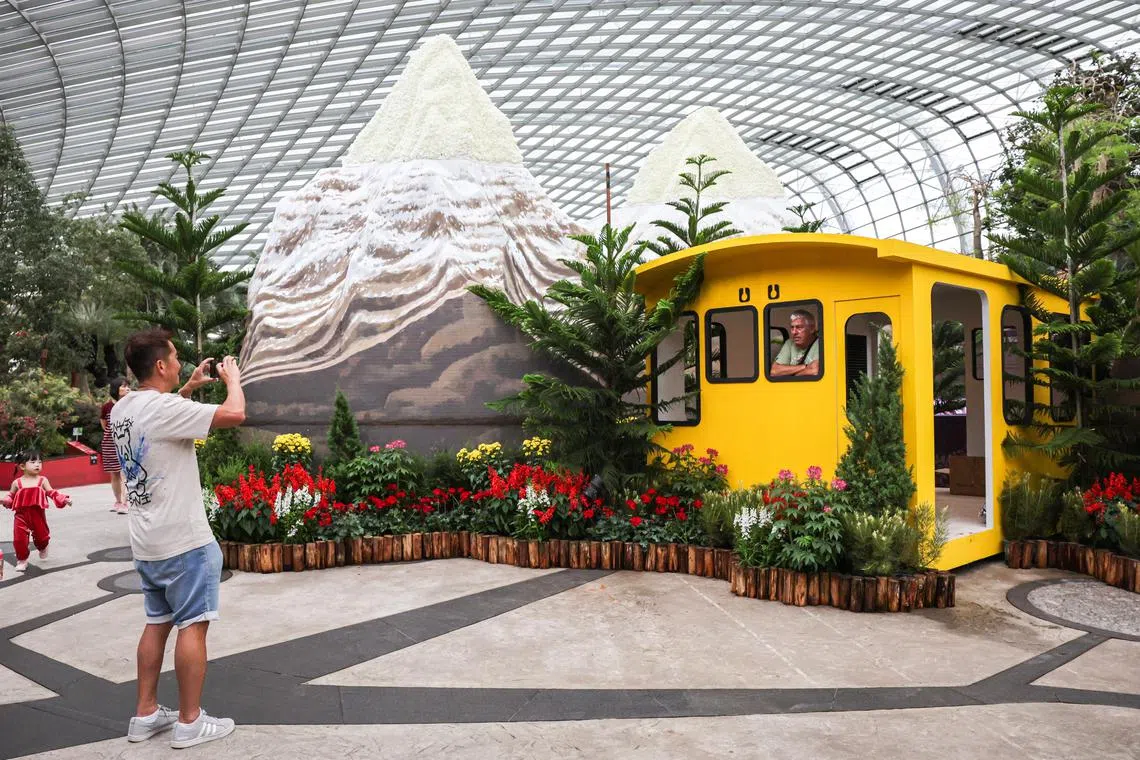
A tourist taking photos of the Golden Spot Cabin with the Matterhorn in the background in the Flower Dome at Gardens by the Bay.
ST PHOTO: GIN TAY
The first Swiss alpine feature in the Flower Dome is a replica of The Golden Spot from Gornergrat summit in Zermatt. The gold-plated historic locomotive, set against a Matterhorn backdrop, is both an Instagram-worthy spot and a tribute to Swiss railway innovation.
The restored HE 2/2 3003 locomotive is the centrepiece at Gardens by the Bay, inviting families to snap mountain-inspired souvenirs. The replica stands 2.5m tall, with a 5m-tall Matterhorn recreation.
Fraumunster Church

A replica of Fraumunster Church (far right).
ST PHOTO: GIN TAY
Another highlight is a replica of Fraumunster Church. The original Zurich abbey, founded in 853 CE on the Limmat, is known for its haunting stained-glass windows created between the 1940s and 1960s by celebrated artists Augusto Giacometti and Marc Chagall. The church blends Romanesque and Gothic architecture featuring vaulted arches, a historic crypt museum and the largest church organ in Zurich.
The Glacier Express

The Glacier Express travelling from Zermatt to Chur on Aug 29.
ST PHOTO: GIN TAY
A Glacier Express cabin at the Flower Dome pays homage to Switzerland’s storied railway. The train connects the towns of Zermatt and St Moritz, crossing 291 bridges and 91 tunnels, allowing travellers to view landmarks such as the Landwasser Viaduct, Oberalp Pass and Rhine Gorge through roof-high windows. Known as the “slowest express train in the world”, it is also famed for comfort, history and splendid scenery.
Swiss folk paper art

Papercutting artist Elisabeth Beutler is known for paper silhouettes inspired by alpine life.
ST PHOTO: GIN TAY
Artist Elisabeth Beutler has mastered the art of Swiss scissor-cutting, or “Scherenschnitt”. The 63-year-old is known for intricate paper silhouettes inspired by alpine life.
Her exhibitions showcase precise Swiss craft, turning cut paper into scenes rooted in Swiss culture. Seven of her popular pieces are displayed inside the Swiss Wooden Chalet.
Swiss Wooden Chalet
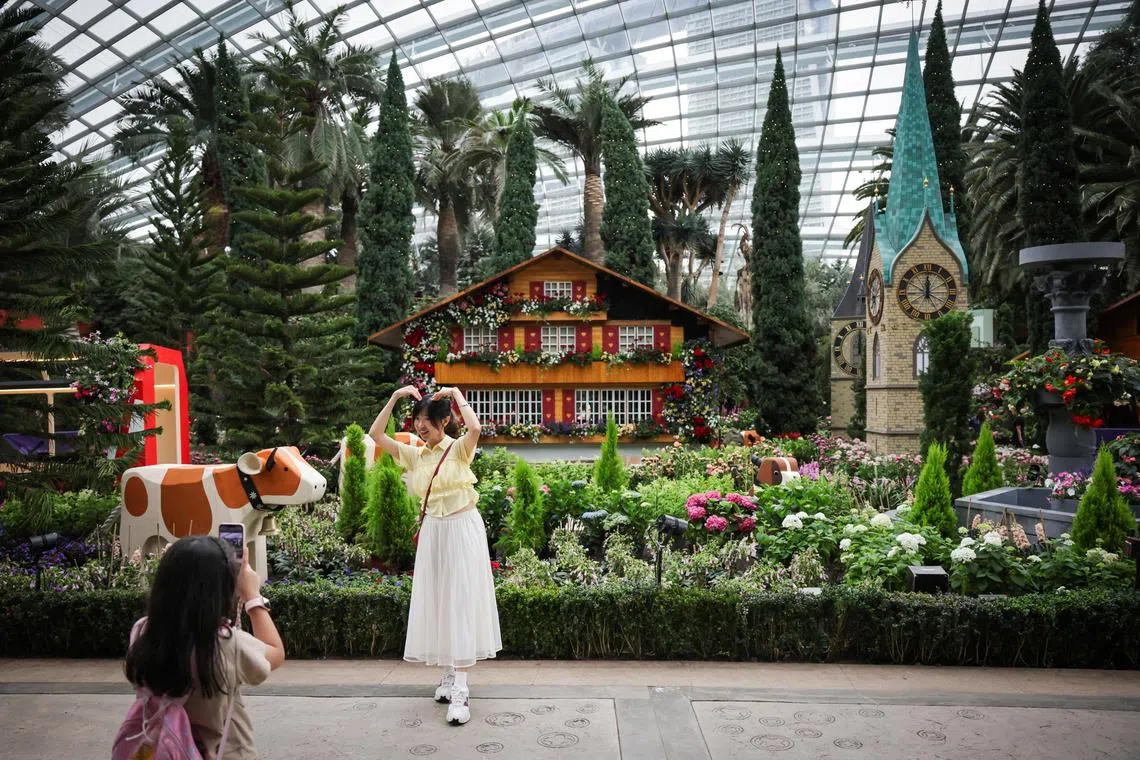
The exhibition includes a replica of a Swiss chalet (background, centre).
ST PHOTO: GIN TAY
A replica of a Swiss wooden chalet stands 4.5m tall and more than 7m wide. Swiss chalets are built from timber on stone foundations, with steep roofs, wide eaves and large windows for mountain views. Carved railings and cosy wood interiors are common, and most include a fireplace for warmth and gathering.
Book It/Alpine Adventure
Where Flower Dome, Gardens by the Bay, 18 Marina Gardens Drive str.sg/BKmz
When Sept 8 to Oct 12, 9am to 9pm daily
Admission From $8 for residents
Info
The writer and executive photojournalist Gin Tay were hosted on this trip by Gardens by the Bay and Switzerland Tourism.
Alpine Adventure is presented in collaboration with Switzerland Tourism, and supported by the Embassy of Switzerland in Singapore, Swiss International Air Lines, Travel Switzerland, Zurich Tourism, Geneva Tourism, Adelboden-Lenk-Kandersteg Tourism, Glacier Express, and Gornergrat Railway.


